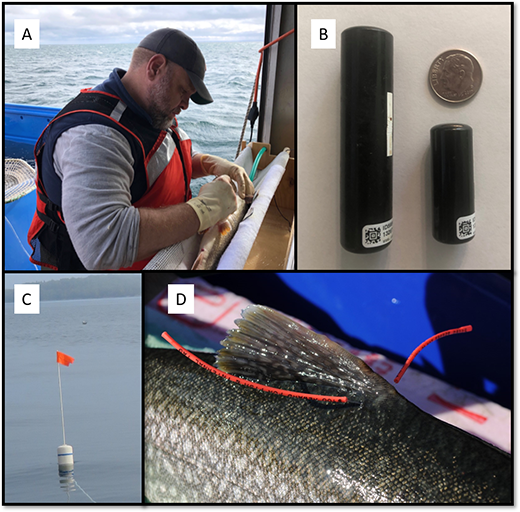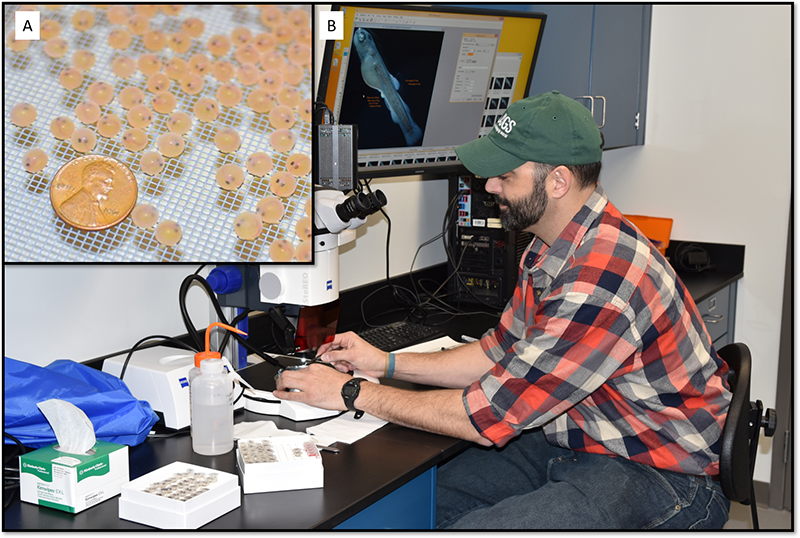Studying the Fish of Buffalo Reef, Traverse Bay, Lake Superior
This story has been re-postedwith permission from the article, "Studying the Fish of Buffalo Reef", published in the Buffalo Reef Task Force Newsletter, August 2020. This project is funded by the Great Lakes Restoration Initiative with additional support from the Great Lakes Fishery Commission. The newsletter is available online at: https://content.govdelivery.com/attachments/MIDNR/2020/08/27/file_attachments/1528136/Buffalo Reef Task Force - Newsletter - August 2020.pdf
As coastal currents transport stamp sands southward along the shoreline of Grand Traverse Bay and onto Buffalo Reef, fine sand—which may contain trace amounts of heavy metals, such as copper—is covering the reef surface and filling the gaps between rocks that provide important protection for lake trout and lake whitefish eggs.
A team of researchers from the Great Lakes Indian Fish and Wildlife Commission, Michigan Department of Natural Resources, Michigan State University, Michigan Technological University and the U.S. Geological Survey is studying the potential effect of stamp sand encroachment on Buffalo Reef to past, present and future generations of lake trout and lake whitefish.
The study has two main objectives: 1) identify where lake trout and lake whitefish are spawning on Buffalo Reef and 2) determine potential effects of the stamp sands on spawning success.
The study will inform future mitigation and restoration efforts for Buffalo Reef.
To achieve the first objective, the research team surgically implanted 50 lake trout and 50 whitefish with telemetry tags (Fig. 1A and 1B). These tags emit a low-power, uniquely coded "ping" that is detected by an array of acoustic telemetry receivers (underwater computers) deployed on Buffalo and Traverse Island reefs.
Receiver locations are marked by a surface float (Fig. 1C) and their configuration covers the entire expanse of Buffalo and Grand Traverse reefs, allowing the team to pinpoint (within a few feet of accuracy) where taggedfish (Fig. 1D) are spawning. These spawning locations will be related to the distribution of stamp sands on Buffalo Reef.
All data collected on receivers will be uploaded to the Great Lakes Acoustic Telemetry Observation System network, the central database for acoustic telemetry studies in the Great Lakes. Working through the GLATOS network will allow the research team to learn when their tagged fish move out of the study area and inform other researchers when their fish are detected along the eastern side of the Keweenaw Peninsula.

Fig. 1(A) Dr. Mike Lowe of the U.S. Geological Survey surgically implants an acoustic tag into an adult lake trout at Buffalo Reef (Tom Binder, MSU photo). (B) V16 (left) and V13 tags that are surgically implanted into lake trout and lake whitefish, respectively. The relative size of each tag is indicated by the dime in upper right-hand corner (Mike Lowe, U.S. Geological Survey photo). (C) Surface float marking the location of a receiver at Traverse Island (Brad Buechel, U.S. Geological Survey photo). (D) External tags on an adult lake trout indicate that this fish has been implanted surgically with an acoustic tag. On each external tag is contact information so fisheries biologists can arrange the return of the tag for future use in another lake trout (Tom Binder, MSU photo).
The second objective is being addressed using a combination of controlled laboratory experiments and fieldwork to assess how residual copper and other heavy metals in stamp sand might affect the early life stages (eggs and larval fish) of lake trout and lake whitefish.
Using the new laboratory facilities at the U.S. Geological Survey’s Hammond Bay Biological Station, each winter, fertilized eggs (Fig. 2A) are incubatedover increasing concentrations of stamp sand in experimental aquariums. Yolk sac consumption, larval growth rate and individual behavior (response to predators and prey capture success) is measured weekly after hatching (Fig. 2B).
Beginning next spring, lake trout and lake whitefish egg distribution and viability, as well as larval fish survival and growth, will be monitored on the two spawning reefs using a combination of divers, remotely operated vehicles and fry (young fish) emergence traps.
In addition, a subsample of the eggs and larvae from these studies will be used by researchers at Michigan Tech to quantify genetic adaptations related to stamp sand concentration. Work on this phase of the project began last winter and is scheduled to run through 2023.

Fig. 2(A) "Eyed-up" lake trout eggs waiting to be placed into experimental treatments. (B) Brad Buechel of the U.S. Geological Survey uses a digital imaging system at the Hammond Bay Biological Station to measure a larval lake trout (Andrea Miehls, Great Lakes Fishery Commission photos).
Lastly, the Buffalo Reef Task Force, through funds provided by the Great Lakes Restoration Initiative, is supporting a new project starting in 2021.
This project would expand the scope of the juvenile fish monitoring programs conducted by tribal fisheries biologists by sampling more frequently and incorporating additional spawning reefs throughout Keweenaw Bay.
This regional, multi-reef comparison will use the abundance, diet and body condition of juvenile fish to better understand how stamp sand impacts the number of lake trout and lake whitefish that move from Buffalo Reef to adjacent nursery areas and, ultimately, grow to become part of the fishery.
A priority task for this research is the identification of natural markers found in fish “ear stones” (otoliths) and genetics that can be used to accurately estimate the contribution of Buffalo Reef to the fishery.
Since fisheries biologists have saved otoliths from previous years, this will enable researchers to calculate the present and past contribution that Buffalo Reef has made to the fishery.
Join the effort: To find more information, including Buffalo Reef Task Force reports, photos, news releases, a task force email sign-up portal and a link to a Michigan Technological University webpage on the effort to protect the reef and its valuable fishhabitat, visit http://www.Michigan.gov/BuffaloReef.
Read more Pulse on Science: Project Spotlights
- New Study Concludes Invasive Sea Lampreys Can Be Controlled by the Release of Sterilized Males
- Happy 75th anniversary to Hammond Bay Biological Station!
- Great Lakes Habitat Restoration: Partnering to Promote Fish Production
- Sea Lamprey Control Spreads the Distance
- Making the Best of a Bad Situation: Great Lakes Sea Lampreys Reveal the Origins of Vertebrate Traits
- Studying the Fish of Buffalo Reef, Traverse Bay, Lake Superior
- Doing Science is Essential...Communicating Science is Just as Critical (and maybe more FUN!)
- Faithful Fish: Walleye Show High Spawning Site Fidelity in the Great Lakes
- Finding the Sea Lamprey's Kryptonite
- Good Things Come in...Polymer Packages?
- Rambunctious Reproduction Overheard Among Great Lakes' Lake Trout
- Clearer Water Means Less Fish: Understanding How Lower Trophic Level Changes Impact Lake Huron's Fisheries

